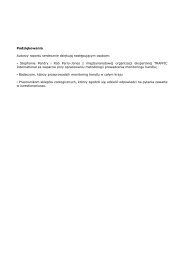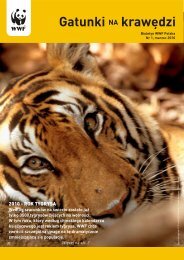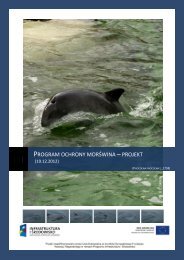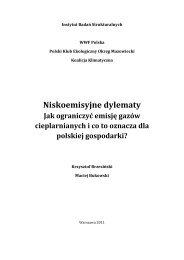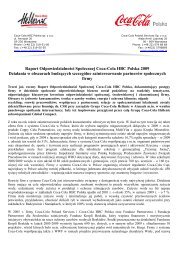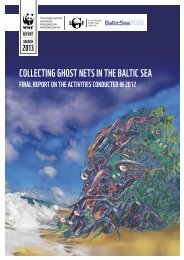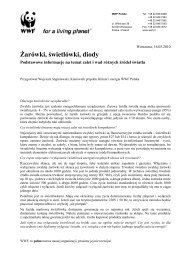Biodiversity, biocapacity and better choices
Biodiversity, biocapacity and better choices
Biodiversity, biocapacity and better choices
You also want an ePaper? Increase the reach of your titles
YUMPU automatically turns print PDFs into web optimized ePapers that Google loves.
likely that climate change will be a more important factor affectingpopulation trends, as well as itself being a driver of habitat loss<strong>and</strong> alteration.Calculating the LPIWhere do the data used in the LPI come from?All data used in constructing the index are time series of eitherpopulation size, density, abundance or a proxy of abundance. Thespecies’ population data used to calculate the index are gathered froma variety of sources. We collate time-series information for vertebratespecies from published scientific literature, online databases (e.g.,NERC Centre for Population Biology [Global Population DynamicsDatabase], Pan-European Common Bird Monitoring Scheme) <strong>and</strong>grey literature. Data are only included if a measure of population sizeis available for at least two years, <strong>and</strong> information available on howthe data were collected, what the units of measurement were <strong>and</strong> thegeographic location of the population. The data must be collected usingthe same method on the same population throughout the time series<strong>and</strong> the data source referenced <strong>and</strong> traceable.The period covered by the index is from 1970 to 2008.The year 2008 is chosen as the “cut-off” year for the index becausethere is not yet enough data to calculate a robust index for 2009-2011. Datasets are currently being added to the database to allowthe calculation of the index for those years.How is the Living Planet Index calculated?The LPI is based on population trends in over 2,600 vertebratespecies worldwide. Data on species’ populations from two or moreyears since 1970 are collected from a wide variety of publishedsources <strong>and</strong> entered into the LPI database. In some cases, wehave data on more than one population of a single species. Foreach population, the rate of change from one year to the nextis calculated. If we have data from only a few, non-consecutiveyears, we assume there was a constant annual rate of change in thepopulation between each data year. Where we have data from manyyears (consecutive or not) we fit a curve through the data pointsusing a statistical method called generalized additive modelling.Where we have more than one population trend for a single species,the average rate of change across all of the populations is calculatedfor each year. Then we calculate the average rate of change acrossall species from year to year. The index is set equal to 1 in 1970, <strong>and</strong>the average annual rate of population change is used to calculatethe index value in each successive year.Technical details of the calculationsAnnual data points were interpolated for time series with six ormore data points using generalized additive modelling, or byassuming a constant annual rate of change for time series with lessthan six data points. First, the average rate of change in each year iscalculated across all populations of a species, then across all species.The average annual rates of change in successive years were chainedtogether to make an index, with the index value in 1970 set to 1.Details of each of the methodologies used for each of the cutsof the LPI are outlined below:a. System LPIsEach species is classified as being terrestrial, freshwater ormarine, according to the system on which it is most dependentfor survival <strong>and</strong> reproduction. The indices for terrestrial,freshwater <strong>and</strong> marine systems were aggregated by giving equalweight to temperate <strong>and</strong> tropical species within each system,i.e., a tropical index <strong>and</strong> a temperate index were first calculatedfor each system <strong>and</strong> the two were then aggregated to create thesystem index.b. Realm LPIsEach species’ population in the LPI database was assigned toa realm according to its geographic location. Realm indiceswere calculated by giving equal weight to each species, withthe exception of the Palearctic realm, in which families wereaggregated with equal weight. This was done because thevolume of time series data for birds available from this realmfar outweighs all other species put together. The data fromIndo-Malaya, Australasia <strong>and</strong> Oceania were insufficient tocalculate indices for these realms, so they were combinedinto a super-realm, Indo-Pacific.How has the Living Planet Index changed sinceLPR 2010?On the whole, the results are very similar to the LPIs in LPR 2010.As we continue to add data, we are consistently seeing the samepatterns of population trend at the global level. The followingsection details changes to the data set since LPR 2010.Increases in the LPI DatabaseThe size of the dataset has increased by 13 per cent since LPR 2010(see Figure 59). As populations in the LPI are continually added,so the average trend for each index changes. As a result, the 2012dataset may show differences in the detail of some of the indicesproduced in 2010, but the overall trajectory of the trend remainsroughly the same.WWF Living Planet Report 2012 page 132 Annex: Technical notes <strong>and</strong> data tables page 133




